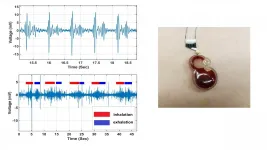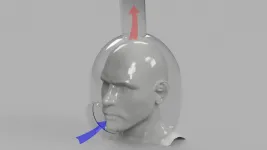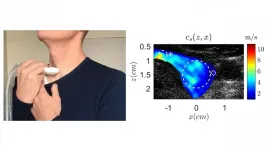Johns Hopkins scientist develops method to find toxic chemicals in drinking water
Chlorination generates hundreds of unregulated byproducts in water
2021-01-12
(Press-News.org) Most consumers of drinking water in the United States know that chemicals are used in the treatment processes to ensure the water is safe to drink. But they might not know that the use of some of these chemicals, such as chlorine, can also lead to the formation of unregulated toxic byproducts.
Johns Hopkins Environmental Health and Engineering Prof. Carsten Prasse proposes a new approach to assessing drinking water quality that could result in cleaner, safer taps.
"We are exposing people in the United States to these chemical compounds without knowing what they even do," Prasse said. "I'm not saying that chlorination is not important in keeping our drinking water safe. But there are unintended consequences that we have to address and that the public needs to know about. We could do more than what we're doing."
Among disinfection byproducts, only 11 compounds are currently regulated in drinking water, according to his paper published in the Royal Society of Chemistry journal Environmental Science: Processes & Impacts. This is in stark contrast to the more than 700 disinfection byproducts that have so far been identified in chlorinated drinking water, he said.
Prasse said the number of disinfection byproducts that are regulated in drinking water have not changed since the 1990s, despite clear scientific evidence for the presence of other toxic compounds.
The existing approach to evaluate chemicals in drinking water is extremely tedious and based on methods that are often outdated, he said. For instance, chemicals are currently evaluated for toxicity by expensive, time-consuming animal studies.
Applying those same methods to the growing number of chemicals in drinking water would not be economically feasible, Prasse said. At a minimum, he added, new methods are needed to identify chemicals that are of highest concern.
Prasse proposes casting a bigger net to capture a more diverse mix of chemicals in water samples. The "reactivity-directed analysis" can provide a broader readout of what's present in drinking water by targeting the largest class of toxic chemicals known as "organic electrophiles."
"This method can help us prioritize which chemicals we need to be paying closer attention to with possible new regulations and new limits while saving time and resources," Prasse said.
This new approach, which takes advantage of recent advances in the fields of analytical chemistry and molecular toxicology, identifies toxicants based on their reactivity with biomolecules such as amino acids, the building blocks of proteins. The new approach simulates this process in order to identify toxic chemicals in drinking water.
"We know that the toxicity of many chemicals is caused by their reaction with proteins or DNA which alter their function and can result, for example, in cancer," Prasse said.
INFORMATION:
Reporters who want to speak with Prasse can contact Doug Donovan at 443-462-2947 or at dougdonovan@jhu.edu.
Johns Hopkins University news releases are available online, as is information for reporters. To arrange a video or audio interview with a Johns Hopkins expert, contact a media representative listed above or visit our studio web page. Find more Johns Hopkins stories on the Hub.
ELSE PRESS RELEASES FROM THIS DATE:
2021-01-12
During a typical year, over a million people visit Yellowstone National Park, where the Old Faithful geyser regularly blasts a jet of boiling water high in the air. Now, an international team of astronomers has discovered a cosmic equivalent, a distant galaxy that erupts roughly every 114 days.
Using data from facilities including NASA's Neil Gehrels Swift Observatory and Transiting Exoplanet Survey Satellite (TESS), the scientists have studied 20 repeated outbursts of an event called ASASSN-14ko. These various telescopes and instruments are sensitive to different wavelengths of light. By using them collaboratively, scientists obtained more detailed pictures of the outbursts.
"These are the most predictable and frequent recurring multiwavelength ...
2021-01-12
WASHINGTON, January 12, 2021 -- A highly sensitive wearable sensor for cardiorespiratory monitoring could potentially be worn continuously by cardiac patients or others who require constant monitoring.
The small and inexpensive sensor, announced in Applied Physics Letters, by AIP Publishing, is based on an electrochemical system involving two ionic forms of iodine, I- and I3-. A solution containing these electrolyte substances is placed into a small circular cavity that is capped with a thin flexible diaphragm, allowing detection of subtle movements when placed on a patient's chest.
Small motions that arise from the heartbeat and breathing cause the flexible diaphragm ...
2021-01-12
Stiffness in our tissues causes tension in our cells. Research from the Buck Institute, the University Health Network (University of Toronto), Stanford University, and the University of Alberta shows that stiffness impacts the innate immune system by upping its metabolism. The findings suggest the cellular tension likely sets off an inflammatory loop that contributes to the development of chronic diseases of aging. Publishing in Cell Reports, Buck Associate Professor Dan Winer, MD, and colleagues present an emerging way of looking at how the immune system functions, possibilities for new immunotherapeutics, and a call for scientists to reconsider the way they do research.
While stiffness ...
2021-01-12
WASHINGTON, January 12, 2021 -- The risk of infection of COVID-19 is high for medical specialists who come in contact with symptomatic or asymptomatic patients. Dentists and otolaryngologists are at particular risk, since they need direct access to the mouth, nose, and throat of patients.
The current solutions, which include wearing N95 masks and face shields, clinic room evacuation, negative pressure rooms, and special air filtration systems, are expensive, not highly effective, and not very accessible.
In Physics of Fluids, by AIP Publishing, researchers at Cornell University discuss their design of an open-faced helmet for patient use ...
2021-01-12
WASHINGTON, January 12, 2021 -- Sodium-ion batteries are a potential replacement for lithium batteries, but the anodes -- positively charged electrodes -- that work well for lithium-ion batteries don't provide the same level of performance for sodium-ion batteries.
Amorphous carbon, which lacks a crystalline structure, is known to be a useful anode, because it has defects and voids that can be used to store sodium ions. Nitrogen/phosphorus-doped carbon also offers appealing electrical properties.
In Applied Physics Reviews, from AIP Publishing, researchers in China from Zhejiang University, Ningbo University, and Dongguan University of Technology ...
2021-01-12
What The Study Did: Variations and changes in national and state rates of neonatal abstinence syndrome and maternal opioid-related diagnoses were examined in this observational study.
Authors: Ashley H. Hirai, Ph.D., of the Health Resources and Services Administration in Rockville, Maryland, is the corresponding author.
To access the embargoed study: Visit our For The Media website at this link https://media.jamanetwork.com/
(doi:10.1001/jama.2020.24991)
Editor's Note: The article includes conflicts of interest and funding/support disclosures. Please see the article for additional information, including other authors, author contributions and affiliations, conflict of interest and financial disclosures, and funding and support.
INFORMATION:
Media advisory: ...
2021-01-12
WASHINGTON, January 12, 2021 -- Singing may be the next-generation, noninvasive approach to determining the health of a patient's thyroid.
Typically, a fine needle is used to detect the presence of a tumor in the thyroid, which most commonly affects children and younger women. However, this method can only detect about 5% of thyroid cancers.
Researchers from Université de Tours, Centre Hospitalier Universitaire de Dijon-Bourgogne, and Université Bourgogne Franche-Comté suggest a simpler approach: singing. They demonstrate the technique in the journal Applied Physics Letters, from AIP Publishing.
"Developing noninvasive methods would reduce the stress of patients during their medical exams," said Steve Beuve, one of the authors. "Having to sing during a medical ...
2021-01-12
What The Study Did: National register data from Denmark were used to examine if people with autism spectrum disorder (ASD) have higher rates of suicide attempts and suicide compared to those without ASD and to identify potential risk factors.
Author: Kairi Kõlves, Ph.D., of Griffith University in Brisbane, Australia, is the corresponding author.
To access the embargoed study: Visit our For The Media website at this link https://media.jamanetwork.com/
(doi:10.1001/jamanetworkopen.2020.33565)
Editor's Note: The article includes funding/support disclosures. Please see the article for additional information, including other authors, author contributions and affiliations, conflict ...
2021-01-12
BOSTON -- For women hoping to achieve a pregnancy using freshly retrieved donor eggs, a new retrospective study led by researchers from Brigham and Women's Hospital may provide important insight. Brigham senior author Janis H. Fox, MD, had observed that when freshly retrieved donor eggs were used, pregnancy rates were higher for fresh compared to frozen embryo transfers. Fox and her colleagues were intrigued by this observation. The team set out to scientifically determine if this observation would be replicated in a larger sample of recipients. Leveraging national data from the Society for Assisted Reproductive Technology (SART), the Brigham researchers found that, in cycles using freshly retrieved donor eggs, fresh embryo transfers were indeed ...
2021-01-12
A detailed analysis of the burden of osteoporosis in eight Eurasian countries has found that osteoporosis is a significant and growing health problem in the region that will escalate in the future due to expected demographic changes.
The authors of the Audit report [1] carried out a review of the available literature and a survey of the representatives of the national osteoporosis societies in eight Eurasian countries. The Audit reviews both the burden and the differences between Armenia, Belarus, Georgia, Moldova, Kazakhstan, the Kyrgyz Republic, the Russian Federation, and Uzbekistan with regard to the prevalence of osteoporosis and incidence of osteoporotic fractures, future demographic changes, diagnostic resources, and treatment availability.
The findings ...
LAST 30 PRESS RELEASES:
[Press-News.org] Johns Hopkins scientist develops method to find toxic chemicals in drinking water
Chlorination generates hundreds of unregulated byproducts in water



